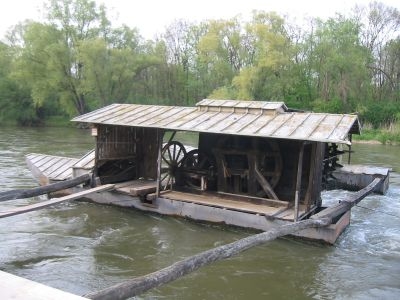Wickerham's Mill Traditional Geocache
-
Difficulty:
-

-
Terrain:
-

Size:  (micro)
(micro)
Please note Use of geocaching.com services is subject to the terms and conditions
in our disclaimer.
I really wanted to put a regular or a small here but that didn't work out so you have this micro instead. Log only/BYOP.
There is no longer a mill here as we tend to now buy our grain products from the grocery store in plastic bags already in bread or muffin form. However, very near this spot on the Little Miami River, 3 miles upstream from where John Garard in 1790 erected the first settlement or "station" in the Virginia Military District, Jacob Wickerham built a floating gristmill near the mouth of Clough Creek the same year.
I traveled back in time and took this photograph of the floating mill: 
This mill was important as it provided corn meal and flour to the 50 or so cabins of hungry Columbia settlers. The mill’s wheel was turned by water flowing through a run along the east bank of the Little Miami. Wickerham increased the amount of water in the natural millrace by constructing a milldam of rock and brush across the width of the stream. Wickerham’s operation was the prototype for the many riverbank mills that settlers would later erect along the length of the Little Miami.
Wickerham also built a station in the vicinity of the mill, but its exact site is unknown.
A man named Oliver M. Spencer wrote a famous narrative of his Shawnee Indian captivity and also lived near the mill as a boy prior to his capture. He reminisced, "it was built in a small flat boat tied to the bank...it was at best barely sufficient to supply meal for the inhabitants of Columbia and the neighboring families and sometimes from low water and other unfavorable circumstances it was of little use so that we were obliged to supply the deficiency from hand-mills a most laborious mode of grinding."
Wickerham’s 1790 mill operated into the early nineteenth century as the most southern mill on the river. After passing through a series of owners, the mill was purchased in 1822 by Philip Turpin and replaced by an up-to-date flourmill built nearby. Turpin obtained a license to ferry customers by boat from the west side of the Little Miami to his mill on the east bank.
Additional Hints
(Decrypt)
ge33